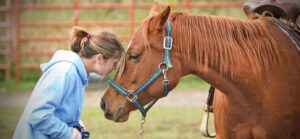Horses – creatures of strength and grace – have healing power. Equine-assisted therapy has become a powerful tool for emotional and physical well-being. Horses offer a unique experience.
Interacting with horses builds trust, self-esteem and communication skills. People learn non-verbal cues and form a bond beyond words. This helps with emotional growth and self-awareness.
Horses don’t judge. They don’t differentiate between people or hold prejudices. This creates a safe place to express without fear of judgement. It also helps process past traumas.
Equine therapy also has physical benefits. Mounted activities help with balance, coordination and muscle strength. Plus, caring for horses is exercise.
Discovering the therapeutic power of horses is a journey. Unlock hidden potential and find healing like no other.
The History of Equine Therapy
Equine therapy is centuries old. Ancient civilizations like Greece and Egypt used it. This type of therapy uses horses to help people feel better emotionally and physically. It has changed over time; from physical rehabilitation to mental health benefits.
Horses give people a sense of calm and trust. They have a gentle nature, so it creates a safe environment for people to express their feelings. This connection between humans and horses has been around for a long time. Especially during war when soldiers found comfort in horses.
Recently, the medical community has recognized equine therapy as a good way to treat some conditions. Kids with autism have improved their communication after horse-assisted therapy. People with anxiety or depression have felt better and healthier after interacting with horses.
Tip: When looking for equine therapy, make sure it’s led by professionals who know what a person needs. The success of this therapy relies on the expertise of the people running the sessions.
The Benefits of Equine Therapy
To fully understand the profound impact of equine therapy, delve into the benefits it offers. Discover the physical benefits, mental and emotional benefits, as well as the social benefits that this therapeutic approach can provide. Explore how horses can be instrumental in promoting healing and personal growth.
Physical Benefits
Equine therapy offers an array of physical advantages which help in overall wellbeing. These benefits can support several elements of one’s health and have a good effect on their life quality.
- Improves coordination and balance: Horseback riding needs frequent posture and body position modifications, aiding to boost coordination and balance.
- Strengthens core muscles: Horseback riding engages the torso muscles, like the abdominal area, back, and hips, thereby improving core strength.
- Ups flexibility: The horse’s movement triggers many muscles, resulting in amplified flexibility and better joint mobility.
- Enhances cardiovascular fitness: Riding horses raises heart rate levels, giving a successful cardiovascular workout and improving overall fitness.
- Raises sensory integration: Interacting with horses allows individuals to use their senses as they react to the animal’s moves, sounds, and touch.
Besides these physical advantages, equine therapy also presents individuals unique chances to create emotional connections with horses. Making these connections can provide emotional support and encourage personal development.
The National Institutes of Health conducted a study which found that equine therapy has been especially advantageous for children with autism spectrum disorder. The therapeutic link between the child and the horse assisted in enhancing social skills, communication capabilities, and self-confidence.
Equine therapy is a holistic healing approach which goes beyond conventional forms of therapy. The combination of physical benefits and emotional connections formed through working with horses makes it an invaluable resource in fostering all-around wellbeing.
Mental and Emotional Benefits
Equine therapy offers many emotional and mental advantages to people wanting therapeutic aid. By connecting with horses, individuals can gain solace, comfort, and healing in ways that conventional therapy may not provide. Here are some of equine therapy’s key benefits:
- Horse-based therapy calms and relaxes. The peaceful nature of these beautiful creatures has a calming effect on people, decreasing their stress and anxiety.
- By forming relationships with horses, people can build trust and make stronger bonds. This can be especially helpful for those who struggle with forming relationships or have experienced trauma.
- Equine therapy helps people to improve communication skills, by needing non-verbal interaction with the horses. People learn to interpret and understand the horse’s body language, making them better communicators with others.
- The physicality of working with horses helps people recognize themselves and raise self-esteem. People gain confidence as they manage and look after these strong animals, increasing their overall sense of worth.
- Horses act as mirrors, reflecting an individual’s feelings and intentions without judgment. This neutral feedback helps people to comprehend their own emotional state, allowing for personal growth.
- Being involved in equine therapy provides a break from daily pressures. Concentrating on the horse’s needs allows individuals to stop thinking about their own issues.
Moreover, equine therapy offers unique traits that set it apart from other therapy approaches. By being surrounded by nature while interacting with these grand animals, people can feel a deep connection between human and animal. The exposed outdoor environment creates a secure place for exploration and contemplation.
To gain the most from equine therapy, try these tips:
1. Take some time to observe the horse’s behavior and movements before engaging with it. This helps form a bond and build trust.2. Participate in grooming and looking after the horse, which encourages an awareness of responsibility and accountability.3. Be mindful while interacting with the horse, focusing on the moment rather than worrying about past or future problems.4. Do simple activities like walking next to the horse or leading it, which can create a sense of companionship and shared objectives.
Each tip contributes to the success of equine therapy by creating a deeper understanding and connection between human and horse. By following these tips, individuals can get the most out of equine therapy’s emotional and mental benefits.
Social Benefits
Social interaction is key for humans. Equine therapy offers many social advantages to improve one’s well-being. Through activities with horses, folks can gain:
- Improved Communication Skills – talking to horses requires clear communication, which translates to better communication skills with people.
- Enhanced Empathy – horses are sensitive to human emotions and can reflect our feelings. Through equine therapy, individuals may learn more empathy for others.
- Increased Self-Confidence – achieving small goals with horses during therapy can boost self-esteem and confidence.
- Sense of Belonging – when in equine therapy programs, individuals experience acceptance, understanding, and inclusion.
- Building Meaningful Relationships – bonds formed with horses during therapy can extend to others, fostering lasting friendships and support systems.
Moreover, equine therapy provides unique details for further social benefits. In an environment free from judgment, individuals can explore their emotions freely while connecting deeply with horses. This non-verbal form of communication allows for true connection without words.
As an example, Sarah is a timid teen with poor self-esteem from years of bullying. Through equine therapy sessions, Sarah found her voice talking to the gentle horses. She gained the courage to express herself with animals and people. This experience helped Sarah move beyond her insecurities and create meaningful friendships.
Equine therapy provides many social benefits such as improved communication, empathy, confidence, a sense of belonging, and the ability to form deep connections. Through this therapy, individuals can unlock their potential for growth and make long-lasting relationships with horses and fellow participants.
How Equine Therapy Works
To better understand how equine therapy works in harnessing the therapeutic power of horses, explore the section on the role of horses in healing, the therapeutic process, and types of equine therapy programs. Discover how these sub-sections provide insights into the efficacy and diverse approaches of this transformative therapy.
The Role of Horses in Healing
The healing ability of horses is remarkable! They can build trust and understanding with humans, providing comfort and support. Horses are incredibly perceptive, sensing fear, sadness, and frustration in individuals. This nonverbal communication helps them feel accepted and understood.
Interacting with horses also requires individuals to be genuinely present and aware. Through activities like grooming, leading, and riding, individuals learn to regulate their emotions and become more attuned to their own body language. This greater self-awareness can lead to emotional regulation and personal growth.
Moreover, equine therapy offers physical advantages. Horseback riding has been proven to improve balance, coordination, strength, and flexibility. It stimulates core muscles and helps individuals build muscle tone while enjoying a therapeutic experience.
Studies have found that equine-assisted therapy can significantly reduce symptoms in depression, anxiety disorders, PTSD, and other mental health conditions. Thus, equine therapy is becoming increasingly recognized by the medical field for its effectiveness in helping people.
Horses are truly special creatures that can have a profound effect on individuals. Their intuitive nature and comforting presence create an environment where individuals can experience true healing and well-being.
The Therapeutic Process
The therapeutic process of equine therapy is essential. Through this, individuals get emotional and physical support from horses, aiding them in their healing journey. Horses have deep empathy and reflect human emotions, creating unique bonds with participants.
During sessions, activities that aid personal growth and self-awareness are done. These could include grooming, leading, or riding the horse, all guided by professionals. Interacting with the gentle creatures builds trust, improves communication skills, and enhances emotional well-being.
Plus, horses’ presence in therapeutic settings can calm individuals. The rhythmic horse’s gait stimulates sensory experiences, relaxing and reducing anxiety. As focus is on the horse’s movements, they learn to regulate their emotions and gain a sense of control.
In addition to emotional benefits, horses offer physical advantages. Riding engages core muscles, boosts balance and coordination, builds strength and flexibility. Plus, individuals have fun and enjoy the experience. This promotes overall well-being and health.
To get the most out of equine therapy, consistency is key. This lets individuals build strong relationships with the horse and the therapist, aiding progress. Setting achievable goals also helps, providing purpose and motivation. Celebrating small victories boosts confidence and furthers growth.
In addition, combining equine therapy with other treatments is beneficial. Working with specialists in equine-assisted interventions ensures comprehensive care. Combining traditional methods with equine-guided activities offers a holistic approach to healing.
Types of Equine Therapy Programs
Equine therapy is a great way to promote emotional, physical, and psychological healing. It uses interactions with horses to create unique approaches to therapy.
There are three types of equine therapy programs:
- Therapeutic Riding: This involves special horseback riding sessions to help with physical and cognitive challenges. It can improve balance, coordination, posture, and muscle strength.
- Equine-Assisted Psychotherapy: This combines psychotherapy with interactions between humans and horses. It helps build trust, communication, empathy, and self-confidence.
- Hippotherapy: This uses the horse’s movements as treatment. The rhythmic motion stimulates the rider’s muscles and nervous system, leading to improved sensory processing and motor control.
These programs create a non-judgmental environment where individuals feel safe expressing themselves. Horses offer unconditional acceptance, which helps create a strong emotional connection between humans and animals.
One example of this is Emily, a young girl with autism. Through therapeutic riding, she was able to build her self-confidence and social skills. She overcame her fear of physical touch and learned how to care for another living being.
Equine therapy programs provide unique opportunities for personal transformation. By tapping into the power of the human-animal bond, they can help individuals heal and grow.
Success Stories: Personal Testimonials
The success stories of equine therapy are essential in showing the significant impact horses have on those looking for healing and renewal. These accounts provide an honest look into the powerful change these majestic creatures can bring.
Witnessing Vulnerability: Through equine therapy, people can let their guard down and accept vulnerability. Horses can sense emotions and give a safe space to explore feelings without fear of judgement.
Fostering Self-Reflection: Interactions with horses can cause moments of deep thought, allowing for personal growth and development.
Cultivating Trust: The therapy encourages trust and respect between the horse and person. This can lead to improved relationships and communication skills.
Empowering Individuals: Working with horses gives a renewed sense of power, resilience, and self-worth. Many report being able to tackle life better after the bond between human and horse.
These success stories span different ages and backgrounds. Equine therapy has helped children recover from trauma, adults manage stress, and veterans heal from war. Horses always show their potential to aid in healing.
Pro Tip: To gain the most from equine therapy, it is important to go in with an open mind and willingness to connect. Horses can guide us to emotional healing beyond words.
Challenges and Criticisms of Equine Therapy
To address the challenges and criticisms surrounding equine therapy, let’s explore the controversies and ethical concerns as well as the limitations and risks involved. This will provide you with a comprehensive understanding of the complex landscape surrounding this therapeutic approach with horses.
Controversies and Ethical Concerns
Controversies remain in equine therapy, so let’s look at a table showing some key issues:
| Concerns | Description |
|---|---|
| Animal Welfare | Some argue using horses for therapy can be stressful or harmful. Care and training must be given to protect their wellbeing. |
| Lack of Regulation | Guidelines and regulations are missing, which raises doubts about the quality and effectiveness of equine therapy. Clear standards are essential for ethical practices. |
| Informed Consent | Obtaining consent from people with limited cognitive abilities is hard. It’s crucial to guarantee they understand the therapy and its risks. |
| Practitioner Qualification | Equine therapy needs skilled practitioners who have both equine knowledge and therapeutic expertise. Ensuring they are qualified and competent is important for ethical standards. |
| Financial Accessibility | Equine therapy can be costly, making it unavailable for those with limited funds. This raises equal access concerns. |
Plus, potential risk factors like allergies, accidents, or triggering adverse psychological reactions are to be considered.
Research studies on long-term outcomes and populations that may benefit most from equine therapy can help address these controversies.
A 2017 study published in the Journal of Clinical Psychology showed equine-assisted interventions had positive effects on various psychological disorders, including anxiety and PTSD symptoms among veterans (source: www.ncbi.nlm.nih.gov).
Though there are still controversies in equine therapy, ongoing conversations and efforts to address ethical concerns can lead to better practices and outcomes.
Limitations and Risks
Equine therapy has its own limitations and risks to consider. Let’s explore them:
- Limited scientific evidence
- Safety concerns
- Qualification standards
- Ethical considerations
- Financial constraints
These don’t take away the value of equine therapy, they just point to areas of improvement. Suggestions to address these:
- Invest in research to strengthen the scientific evidence base
- Implement safety protocols and training
- Develop standardized accreditation
- Promote ethical guidelines
- Explore funding options
By facing these challenges, equine therapy can stay a valuable therapeutic approach that helps many people.
Conclusion: The Future of Equine Therapy
Equine therapy: A powerful method of healing. Countless individuals benefit from it. The future of equine therapy holds potential for further growth. We can expect to see new applications and techniques.
Technology and equine therapy could merge, with virtual reality platforms offering immersive experiences. Especially helpful for those who can’t access horses. Equine therapy has shown promise in treating conditions such as PTSD and ASD. Demand for effective treatment options is rising.
A story that highlights the transformation power of equine therapy: Emily suffered from severe anxiety and social isolation. With regular sessions with a therapy horse, trust and social skills developed. Today, Emily is doing well, thanks to the help of these gentle beings.
Additional Resources: Books, Organizations, and Websites for Further Exploration.
If you’re keen to experience the healing power of horses, there’s an array of resources at your disposal! Here are five to consider:
- Books – for instance, “The Tao of Equus” by Linda Kohanov or “Horse Sense and the Human Heart” by Adele von Rust McCormick.
- Organizations – e.g. Professional Association of Therapeutic Horsemanship International (PATH Intl) or EAGALA (Equine Assisted Growth and Learning Association).
- Websites – think HorseWorldConnect.com and HorseTherapy.com.
- Research Papers – such as those published in The Journal of Equine Veterinary Science.
- Podcasts – e.g. “Healing Horses” by Carly Kade Creative.
For something a bit different, check out Equi-Health Canada for first aid training tailored to horses. It’s great for those working one-on-one with horses in therapeutic settings.
Pro Tip: When perusing these resources, make sure to take notes or bookmarks for later! This’ll help you build your own library on this exciting field.
Frequently Asked Questions
1. What is Healing Hooves and what is its purpose?
Healing Hooves is a therapeutic program that utilizes horses to improve physical, emotional, and cognitive well-being. Its purpose is to provide a unique and effective approach to therapy by incorporating the healing power of horses into various treatment programs.
2. How does equine therapy work?
Equine therapy, also known as horse therapy or hippotherapy, utilizes the movement and connection with horses to promote healing. The rhythmic motion of a horse’s gait can improve balance, coordination, and muscle strength, while the bond formed between the horse and participant can enhance emotional and psychological well-being.
3. Who can benefit from Healing Hooves?
Healing Hooves is beneficial for individuals of all ages facing various challenges such as physical disabilities, mental health conditions, trauma, autism spectrum disorder, and anxiety, among others. It can also be a valuable support for individuals needing personal growth and development.
4. Is horseback riding experience necessary to participate in Healing Hooves?
No prior horseback riding experience is required. Healing Hooves is designed to accommodate both beginners and experienced riders. The program is tailored to the individual’s needs and abilities, ensuring a safe and effective therapeutic experience for all participants.
5. Are there any safety precautions taken during Healing Hooves sessions?
Absolutely. Safety is a top priority in all Healing Hooves sessions. Trained professionals closely monitor each session, and horses are selected for their gentle nature and reliability. Participants are provided with appropriate safety gear and are instructed on correct procedures to ensure a secure and comfortable experience.
6. How can I get involved with Healing Hooves?
If you are interested in getting involved with Healing Hooves, you can reach out to our program coordinator or visit our website for more information. We offer volunteer opportunities, donation options, and sponsorships to support our mission of providing therapeutic services through the power of horses.



